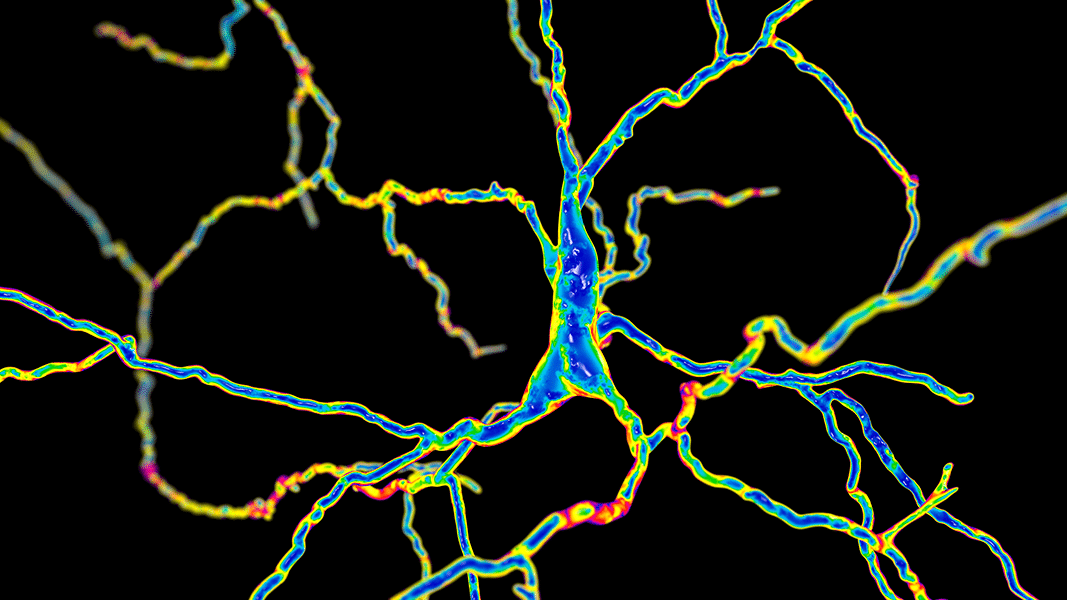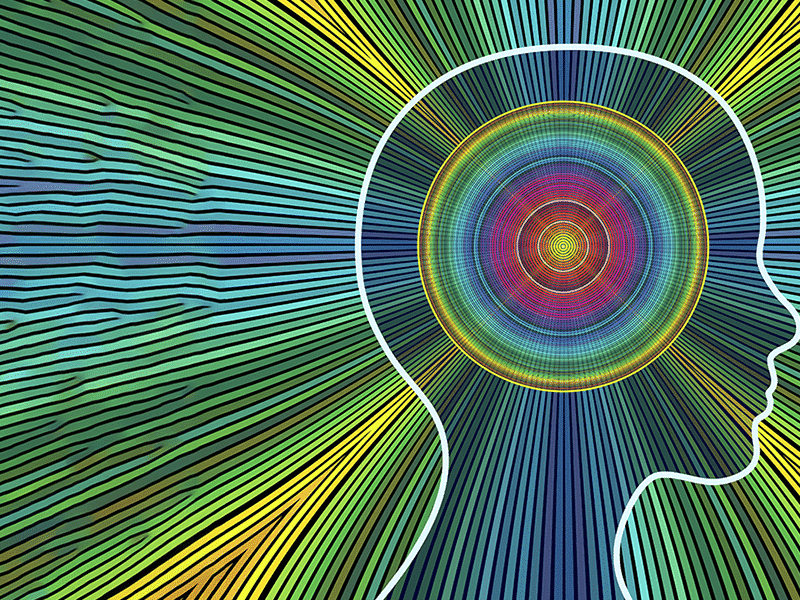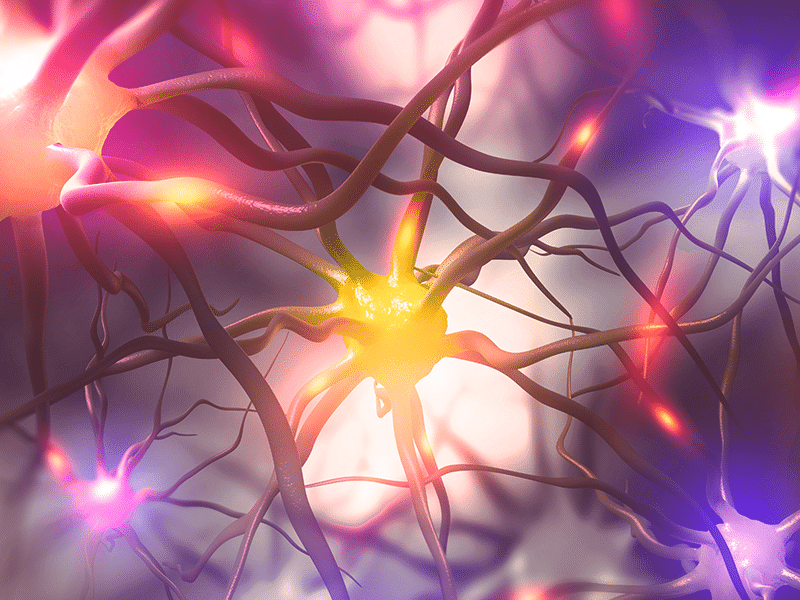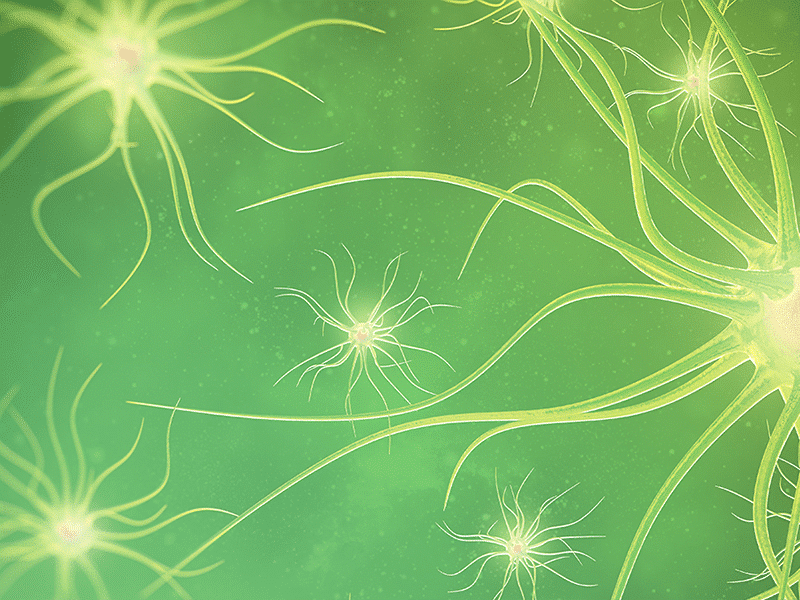Research Summary:
Huntington’s disease is an inherited neurodegenerative disorder that tends to arrive in adulthood with a progressive decline in motor control and cognitive function. It often begins with mood changes, followed by a lack of coordination and an unsteady gait, and ending with severe, uncoordinated movements of the body and dementia. Death usually occurs within 20 years of diagnosis. A disease of the brain’s basal ganglia (movement center), it’s linked to a faulty version of huntingtin – a protein with unknown function but one that interacts with over 100 proteins and can be toxic to certain cell types. At the biochemical level, Huntington’s leads to imbalances in dopamine and glutamate (the brain’s primary excitatory neurotransmitter) which causes excitotoxicity (neuron death via overexcitation). There is no known cure but the available treatments may provide some help with symptom relief and quality of life.
One hallmark of the disease is an early loss of CB1 receptors and endocannabinoid dysregulation, especially in the basal ganglia, leading to a loss of control over glutamate levels and to damaging levels of excitation in the brain. This suggests using cannabinoids as a treatment but despite positive reviews of the literature, the few studies in human have been mixed. In a double-blind study with Sativex (a 1:1 THC:CBD formulation) in 24 patients for 12 weeks, the researchers found no change in symptoms. But in 7 case studies, cannabinoids improved a range of motor symptoms and behavioral problems. A pilot study with nabilone (a pharmaceutical THC derivative) in 44 patients found help with motor control, chorea (involuntary spasmodic movements), cognition, and behavior while another study found that nabilone increased choreatic movements. An early study in 15 people found 6 weeks of 700 mg of isolated CBD per day to be nontoxic but not effective for symptoms.
However, the studies in preclinical models suggest we should continue to explore clinical trials. In a mouse model of Huntington’s disease, activating the CB1 receptor helped to prevent and rescue memory deficits and in another study, CBD or delta-8 THC extracts helped to protect the basal ganglia via regulation of metabolism and energy levels. In mice engineered to have no CB1 receptors, inducing Huntington’s disease led to worse motor symptoms than in wildtype mice. In a rat model of Huntington’s disease, Sativex worked via the CB1 and CB2 receptors to reduce brain leaks, neuron degeneration, glial activation (guardian immune cells of the brain), and neuroinflammation while activating the CB2 receptor protected from excitotoxicity. Extracts of CBD and THC were also shown to be protective because of their ability to increase antioxidation agents and to reduce brain atrophy.
From the Project CBD Archives:
Full-Spectrum Brain Boost
The neuroprotective properties of CBD and other cannabis components.
Brain Science & the ECS: Greg Gerdeman
Greg Gerdeman discusses brain science, the neurobiology of stress, and the ECS.
The Endocannabinoid System & the Brain
Mental health, cognition, emotion, and other processes seated in the brain are regulated by cannabis-sensitive receptors.
Best Review Articles:
- 2022: A chapter suggesting the use of cannabinoids for treating Huntington’s disease
Endocannabinoid System as a New Therapeutic Avenue for the Treatment of Huntington’s Disease - 2020: A metareview of cannabis for Huntington’s disease looks at 22 studies
Medical Marijuana Effects in Movement Disorders, Focus on Huntington Disease; A Literature Review
“A total of 22 studies were reviewed. There was strong evidence for significant improvement in the neurologic symptoms of spasms, tremors, spasticity, chorea, and quality of sleep following treatment with medical marijuana. Analysis of specific motor symptoms revealed significant improvement after treatment in tremors and rigidity. Furthermore, all pretreatment and post-treatment measures indicated a significant increase in average number of hours slept.” - 2012: An excellent review of the background & biochemistry of the disease
Cannabinoids: novel medicines for the treatment of Huntington’s disease - 2008: A review with excellent charts
The endocannabinoid system in Huntington’s disease
Research Timeline
- 2022: For Huntington’s disease, a computer analysis of GABA & glutamate looks at why the disease’s disruption of the endocannabinoid system causes more disease progression
Cannabinoid signaling and risk in Huntington’s disease - 2022: In a mouse model of Huntington’s disease, as the disease progressed the levels of CB1 decreased in the hippocampus (a memory center of the brain) & activating the CB1 receptor helped to prevent & rescue memory deficits
Cannabinoid receptor in hippocampal hippocampus as a potential therapeutic treatment for the cognitive deficits in Huntington diseases - 2018: In a mouse model of Huntington’s disease, 2-AG can help restore dopamine levels to help with motivation & psychological effects
Inhibition of endocannabinoid degradation rectifies motivational and dopaminergic deficits in the Q175 mouse model of Huntington’s disease - 2018: 7 case studies of patients with early onset Huntington’s disease where cannabinoids (mainly Sativex, nabilone & dronabinol) improved motor symptoms, especially dystonia, & led to improvement of care, gait and fine motor skills & weight gain as well less irritability, apathy & hypersalivation
Cannabinoids for Treatment of Dystonia in Huntington’s Disease - 2017: In a mouse model of Huntington’s disease, CBD or delta-8 THC extracts improved motor control, protected the basal ganglia from the slowing of metabolic activity & helped to normalize markers related to energy failure, mitochondrial dysfunction & excitotoxicity
Effects of a Sativex-Like Combination of Phytocannabinoids on Disease Progression in R6/2 Mice, an Experimental Model of Huntington’s Disease - 2016: In humans with Huntington’s disease, Sativex (a 1:1 THC:CBD formulation) found to be safe but didn’t change symptoms (24 patients in a double-blind, randomized, cross-over, placebo-controlled, pilot trial)
A double-blind, randomized, cross-over, placebo-controlled, pilot trial with Sativex in Huntington’s disease - 2016: Brain scans show that loss of CB1 receptors linked to disease onset & progression
CB1R PET in premanifest and manifest Huntington’s disease is related to disease onset and disease burden - 2012: In a rat model of Huntington’s disease, Sativex (a 1:1 THC:CBD formulation) reduced brain leaks, reduced neuron degeneration, lessened glial activation (guardian immune cells of the brain) & reduced inflammation via the CB1 & CB2 receptors
Sativex-like combination of phytocannabinoids is neuroprotective in malonate-lesioned rats, an inflammatory model of Huntington’s disease: role of CB1 and CB2 receptors - 2012: In a mouse model of Huntington’s disease, CB1 levels are reduced in GABA neurons but not glutamate
Unbalance of CB1 receptors expressed in GABAergic and glutamatergic neurons in a transgenic mouse model of Huntington’s disease - 2011: In a rat model of Huntington’s disease, brain scans show early regional dysfunctions in endocannabinoid signaling in the lateral globus pallidus & caudate-putamen with CB1 measurements perhaps being a useful early biomarker
Metabolic and type 1 cannabinoid receptor imaging of a transgenic rat model in the early phase of Huntington disease - 2011: In a mouse model of Huntington’s disease, CB1 knockouts show worse motor symptoms & susceptibility to the toxic agent
Worsening of Huntington disease phenotype in CB1 receptor knockout mice - 2011: In a rat model of Huntington’s disease, CBD & THC extracts found to be neuroprotective via the superoxide dismutase (antioxidant) machinery & reduction of inflammatory cytokines
Neuroprotective effects of phytocannabinoid-based medicines in experimental models of Huntington’s disease - 2011: In a mouse model of Huntington’s disease, not having CB1 receptors worsened disease progression while activating them with THC helped possibly via control of neutrophic factors
Loss of striatal type 1 cannabinoid receptors is a key pathogenic factor in Huntington’s disease - 2010: In cellular model of Huntington’s disease, activating CB1 protected against cell death via ERK
Neuroprotective potential of CB1 receptor agonists in an in vitro model of Huntington’s disease - 2010: In humans with Huntington’s disease, scans show large widespread reduction of CB1 levels even in early disease stages
Widespread decrease of type 1 cannabinoid receptor availability in Huntington disease in vivo
“consistent with the hypothesis that mutant huntingtin represses CB1 transcription.” - 2010: In a rat model of Huntington’s disease, brain studies show involvement of endocannabinoid transmission
Type 1 cannabinoid receptor mapping with [18F]MK-9470 PET in the rat brain after quinolinic acid lesion: a comparison to dopamine receptors and glucose metabolism
“suggesting that CB1 receptor upregulation in the cerebellum is related to a better functional outcome.” - 2010: In a mouse model of Huntington’s disease, THC, a CB1 agonist & an inhibitor of endocannabinoid metabolism did nothing for disease progress but the inhibitor did preserve CB1 levels in the striatum
Behavioural and molecular consequences of chronic cannabinoid treatment in Huntington’s disease transgenic mice - 2009: In humans with Huntington’s disease, nabilone (a pharmaceutical THC derivative) helpful for symptoms (44 patients in a double-blind, placebo-controlled, cross-over)
A pilot study using nabilone for symptomatic treatment in Huntington’s disease - 2009: In a rat model of Huntington’s disease, activating the CB2 receptor protected against toxicity & inflammation
Cannabinoid CB2 receptor agonists protect the striatum against malonate toxicity: relevance for Huntington’s disease
“CB2 receptors are scarce in the striatum in healthy conditions, but they are markedly upregulated after the lesion with malonate.” - 2009: In a mouse model of Huntington’s disease, CB2 receptors on the microglia (guardian immune cells) are protective from the excitotoxicity
Microglial CB2 cannabinoid receptors are neuroprotective in Huntington’s disease excitotoxicity. - 2009: In a mouse model of Huntington’s disease, loss of CB1 precedes the onset of symptoms
Altered CB1 receptor and endocannabinoid levels precede motor symptom onset in a transgenic mouse model of Huntington’s disease - 2009: In humans with Huntington’s disease, changes in the CB1 & GABA receptors
Cannabinoid (CB(1)), GABA(A) and GABA(B) receptor subunit changes in the globus pallidus in Huntington’s disease - 2007: In a rat model of Huntington’s disease, CBD reduced brain atrophy via increased superoxide dismutase (antioxidant) machinery
Cannabidiol reduced the striatal atrophy caused 3-nitropropionic acid in vivo by mechanisms independent of the activation of cannabinoid, vanilloid TRPV1 and adenosine A2A receptors - 2006: In a rat model of Huntington’s disease, activating the CB1 receptor prevented the rise in glutamate levels & electrical brain changes as well as lessening damage via the CB1 receptor
The cannabinoid receptor agonist WIN 55,212-2 attenuates the effects induced by quinolinic acid in the rat striatum - 2006: In a case report on Huntington’s disease, nabilone (a pharmaceutical THC derivative) helpful for symptoms like irritability
Nabilone could treat chorea and irritability in Huntington’s disease - 2006: In a rat model of Huntington’s disease, an inhibitor of anandamide uptake helped to control the jerky motions possibly via modulation of GABA & glutamate in the globus pallidus & the substantia nigra, respectively
UCM707, an inhibitor of the anandamide uptake, behaves as a symptom control agent in models of Huntington’s disease and multiple sclerosis, but fails to delay/arrest the progression of different motor-related disorders - 2005: In a rat model of Huntington’s disease, arvanil (an activator of endocannabinoids & endovanilloids) helped with hyperkinesia (jerky movements) via increased glutamate in the globus pallidus
Arvanil, a hybrid endocannabinoid and vanilloid compound, behaves as an antihyperkinetic agent in a rat model of Huntington’s disease - 2004: In a rat model of Huntington’s disease, CB1 levels were lower & THC was neuroprotective
Potential involvement of cannabinoid receptors in 3-nitropropionic acid toxicity in vivo - 2004: failed patent for CB2 agonists to treat Huntington’s disease
- 2003: In a rat model of Huntington’s disease, CB1 agonists protect against excitotoxicity
Effects of cannabinoids in the rat model of Huntington’s disease generated by an intrastriatal injection of malonate - 2003: In a rat model of Huntington’s disease, an inhibitor of endocannabinoid uptake (AM404) helped with motor problems & the vanilloid receptors seem to play a major role
Compounds acting at the endocannabinoid and/or endovanilloid systems reduce hyperkinesia in a rat model of Huntington’s disease - 2002: In a rat model of Huntington’s disease, loss of CB1 may be linked to pathology
Loss of mRNA levels, binding and activation of GTP-binding proteins for cannabinoid CB1 receptors in the basal ganglia of a transgenic model of Huntington’s disease - 2002: In a rat model of Huntington’s disease, the late stages saw a loss of CB1 receptors in the globus pallidus & the caudate-putamen but no changes in the substantia nigra & the entopeduncular nucleus
Loss of cannabinoid CB(1) receptors in the basal ganglia in the late akinetic phase of rats with experimental Huntington’s disease - 2002: In a rat model of Huntington’s disease, they had lower levels of the CB1 & the lowering of endocannabinoid uptake (AM4040) improved motor disturbances via the lowering of the toxic levels of GABA & dopamine in the basal ganglia
Alleviation of motor hyperactivity and neurochemical deficits by endocannabinoid uptake inhibition in a rat model of Huntington’s disease - 2001: In a rat model of Huntington’s disease, they had a lower level of CB1 in the basal ganglia as well as less anandamide & 2-AG in the striatum & substantia nigra (basal ganglia subregions)
Changes in endocannabinoid transmission in the basal ganglia in a rat model of Huntington’s disease - 2000: In human brains with Huntington’s disease, the pattern of neurodegeneration on different neurotransmitters
The pattern of neurodegeneration in Huntington’s disease: a comparative study of cannabinoid, dopamine, adenosine and GABA(A) receptor alterations in the human basal ganglia in Huntington’s disease - 1999: In humans with Huntington’s disease, nabilone (a pharmaceutical THC derivative) increases jerky movements
Nabilone increases choreatic movements in Huntington’s disease - 1991: In 15 humans with Huntington’s disease, CBD at 700 mg/day for 6 weeks was nontoxic but not effective for symptoms
Controlled clinical trial of cannabidiol in Huntington’s disease




